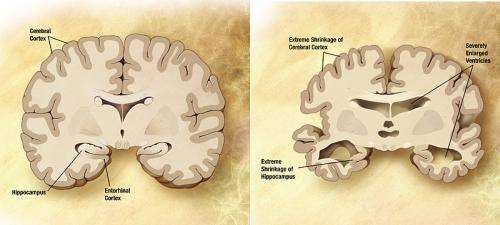Protein involved in hibernation protects against neurodegeneration in mice

Researchers at the Medical Research Council Toxicology Unit at the University of Leicester have identified a molecular mechanism that helps protect brain cells against a fall in core body temperature, which also appears to protect against neurodegeneration in mice.
Nerve cells communicate at junctions called synapses, which are fluid and can be formed and lost in response to triggers such as activity, damage or changes in the environment. They are also lost in neurodegenerative diseases such as Alzheimer's and prion diseases like CJD. Researchers have shown that when the body's core temperature drops, such as when mammals hibernate or during hypothermia, synapses break down and brain activity slows. Once the body returns to normal temperature again, synapses can regenerate to allow the brain to function at full capacity once more.
The researchers studied some of the molecular events that control this process, including activation of a protein called RBM3. RBM3 protects nerve cells from damage at low temperatures but is also able to trigger the regeneration of synapses when the body recovers. The researchers wanted to investigate whether altering levels of RBM3 could protect nerve cells against neurodegeneration in the absence of a drop in body temperature.
They first studied the brains of mice whose temperature was lowered to 16-18ºC for 45 min – mimicking the low temperatures experienced by other species of small mammals that hibernate. They found that the numbers of synapses fell on cooling, particularly in an area of the brain involved in memory, but these connections regenerated when the animals recovered. When they repeated this investigation with mice bred to show signs of neurodegeneration – re-creating damage seen in Alzheimer's and prion disease – the synapses were not able to regenerate again. In these animals, the team found that RBM3 did not respond to cooling and was not kick-starting the recovery process, suggesting the protein is key to protecting and regenerating synapses.
The researchers then boosted levels of RBM3 in mice experiencing neurodegeneration, at normal temperature. They found that this was able to protect nerve cells against neurodegeneration and slow the memory problems usually developed by the mice. The researchers suggest that this mechanism could be targeted to develop new treatments to protect nerve cells against diseases like Alzheimer's.
Dr Eric Karran, Director of Research at Alzheimer's Research UK, the UK's leading dementia research charity, said:
"This promising study highlights a natural process nerve cells use to protect themselves, which could be harnessed successfully in mice to resist damage associated with neurodegenerative diseases. It's still unclear exactly how and why nerve cells die in diseases like Alzheimer's, but a future treatment able to bolster nerve cells against damage could have wide-reaching benefits.
"This research is at an early stage and will need exploring further in humans before we know whether it could be developed into an effective treatment for diseases like Alzheimer's. There is currently a desperate lack of effective treatment options for people with dementia. Research to uncover the key biological mechanisms keeping brain cells healthy is important, as it provides more avenues for investigation in the search for treatments that could make a real difference to people's lives."
More information: "RBM3 mediates structural plasticity and protective effects of cooling in neurodegeneration." Nature (2015) DOI: 10.1038/nature14142

















